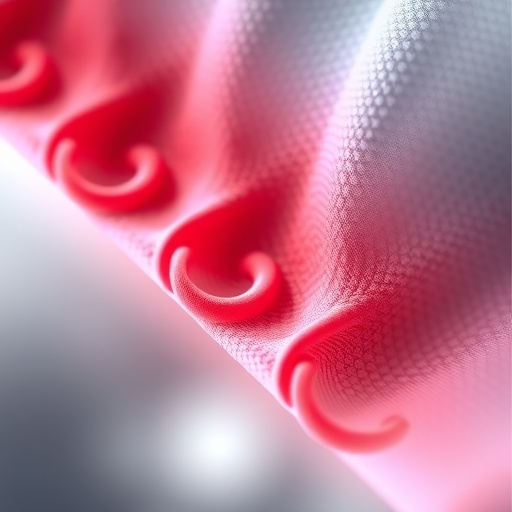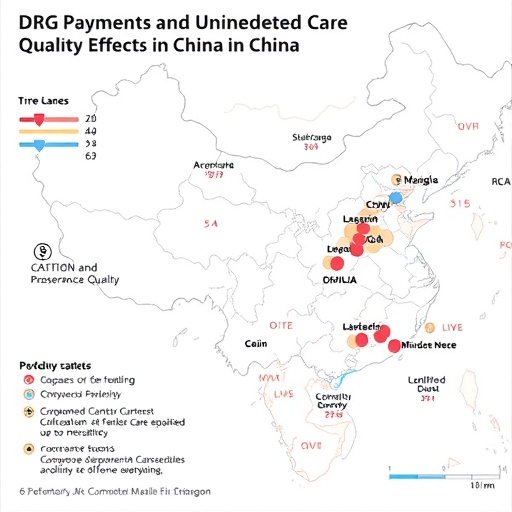In a groundbreaking advancement set to redefine emergency medicine and surgical care, a research team has developed a pioneering blood-triggered self-sealing and tissue adhesive hemostatic nanofabric. This revolutionary material, reported in Nature Communications, promises dramatic improvements in controlling bleeding, accelerating wound closure, and enhancing patient outcomes in critical scenarios ranging from battlefield injuries to routine surgeries.
At the core of this innovation is a nanofabric engineered with a unique responsiveness to blood components, enabling it to activate precisely when and where it is needed most. Unlike conventional hemostats or adhesives, which often require external interventions or exhibit suboptimal sealing capabilities, this nanofabric harnesses the intrinsic properties of the blood to initiate rapid sealing and adhesion. This self-sealing mechanism has the potential to significantly reduce blood loss, a primary cause of mortality worldwide.
The underlying technology utilizes a sophisticated assembly of nanoscale fibers functionalized with biomolecular moieties reactive to blood constituents such as fibrinogen and thrombin. When exposed to bleeding tissue, the nanofabric undergoes a conformational transformation, enabling it to cross-link with blood proteins and surrounding tissue matrices. This dynamic molecular interaction not only halts bleeding promptly but also securely anchors the nanofabric to the tissue, preventing dislodgement and maintaining hemostasis even under mechanical stress.
The implications of this technology extend well beyond controlling hemorrhage. By integrating adhesive properties into the hemostatic function, the nanofabric also facilitates tissue repair and wound closure, reducing the time to healing and minimizing scar formation. The adhesive strength mirrors that of natural extracellular matrix interfaces, ensuring biocompatibility and mitigating immune responses typically induced by synthetic materials.
A particularly striking aspect of this innovation is its built-in responsiveness to the blood’s enzymatic environment. By coupling the nanofabric’s sealing and adhesive activation to thrombin activity, the material ensures site-specific functionality. This specificity prevents premature activation and prolongs shelf life, which is a significant advantage over current hemostatic products that can degrade or lose efficacy over time.
Preclinical tests demonstrated that the nanofabric effectively reduced bleeding times in severely injured animal models, outperforming standard gauze and commercial hemostats. The rapid self-sealing action curtailed hemorrhagic shock—a leading cause of preventable death—underscoring the nanofabric’s potential in trauma care. Furthermore, histological analyses revealed minimal inflammatory infiltration, corroborating the material’s favorable biocompatibility profile.
The design also addresses common logistical challenges with traditional hemostats. Its lightweight and flexible nature permit easy storage and rapid deployment in emergency kits, ambulances, and field hospitals. Unlike bulky or rigid bandages, the nanofabric can be integrated into wearable devices or surgical meshes, broadening its utility across medical disciplines.
Another dimension of this breakthrough is its potential synergy with emerging technologies. The intrinsic nanostructuring allows incorporation of drug delivery capabilities. It could be engineered to release antibiotics, growth factors, or analgesics locally, thereby providing a multifunctional platform that not only stops bleeding but also actively promotes healing and infection control.
The research’s success stems from an interdisciplinary approach combining materials science, bioengineering, and clinical insights. By translating molecular-level interactions into macroscopic functionality, the team has achieved a biomimetic solution that addresses longstanding challenges in hemostasis and wound management. Their effort exemplifies how nanoscale engineering can be tailored for tangible improvements in patient care.
Looking ahead, the researchers envision adapting the nanofabric to various tissue types, including mucosal and internal organs, where hemostasis is often difficult to achieve and conventional methods fall short. Customization of the nanofabric’s biochemical and mechanical properties could open pathways in minimally invasive surgeries, gastrointestinal bleeding control, and even organ transplantation safety.
To facilitate clinical translation, ongoing studies aim to optimize the nanofabric’s manufacturing scalability and regulatory compliance. Ensuring sterilization without compromising functional integrity, validating long-term safety in human trials, and developing user-friendly application devices remain key milestones before widespread adoption.
The social impact of this innovation cannot be overstated. Hemorrhage remains a leading cause of death worldwide, especially in resource-limited settings lacking access to surgical intervention. A simple, effective, and self-activating hemostatic material could dramatically reduce mortality in trauma, childbirth complications, and accidents, transforming emergency and surgical care globally.
Moreover, this nanofabric speaks to the future of personalized medicine. Its responsive and adaptable nature could be calibrated to individual patient coagulation profiles, minimizing risks of thrombosis or excessive bleeding. Such fine-tuned approaches could revolutionize perioperative management and chronic wound care, sectors that currently pose significant clinical challenges.
In conclusion, the blood-triggered self-sealing and tissue adhesive hemostatic nanofabric developed by Fang, Wang, Zheng, and colleagues represents a leap forward in biomaterials and emergency medicine. By intelligently exploiting blood’s own chemistry to initiate sealing and adhesion, this material offers rapid, robust, and biocompatible hemorrhage control. As further refinements and clinical validations unfold, this technology stands poised to become an indispensable tool for surgeons, paramedics, and caregivers worldwide, saving countless lives and redefining standards of care.
Article Title: Blood-triggered self-sealing and tissue adhesive hemostatic nanofabric
Article References:
Fang, Y., Wang, L., Zheng, X. et al. Blood-triggered self-sealing and tissue adhesive hemostatic nanofabric. Nat Commun 16, 4910 (2025). https://doi.org/10.1038/s41467-025-60244-z
Image Credits: AI Generated
Tags: advanced hemostatic solutionsbattlefield injury treatmentbiomolecular interactions in wound healingblood-activated hemostatic nanofabricblood-triggered medical materialsemergency medicine innovationshemostatic nanofabric researchnew materials in surgeryreducing blood loss in emergenciesself-sealing tissue adhesivesurgical care advancementswound closure technology





